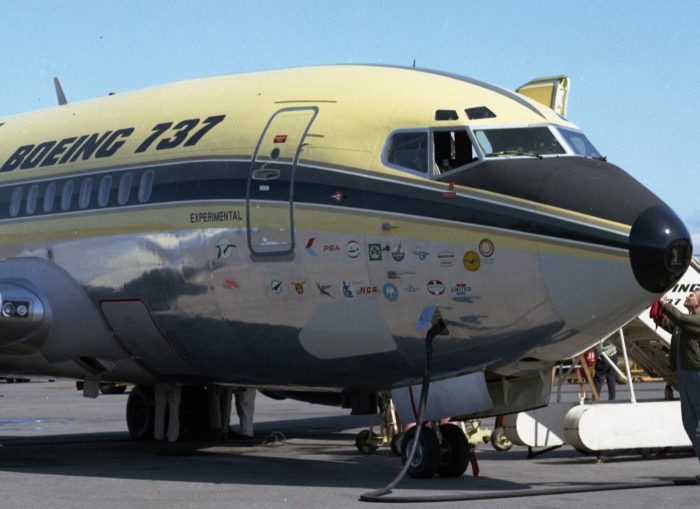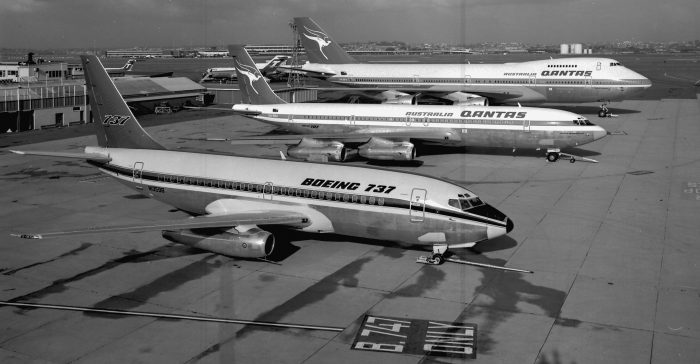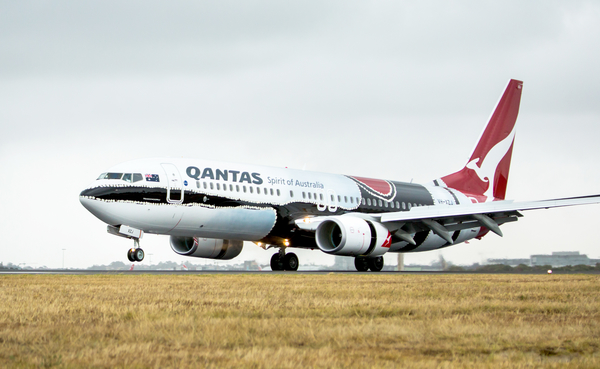
Nice eyebrows : Early 737s featured a second set of windows above the main cockpit windscreen. They were designed to give pilots more visibility however rumour has it pilots would tape over the windows to avoid getting sunburnt.
If you’ve flown with us in the past few years, chances are you’re one of the millions of passengers who has boarded a Qantas Boeing 737-800.
The twin-engine jet is the workhorse of our domestic fleet, and also makes short hops to New Zealand, Singapore, Bali and Noumea in New Caledonia.
And 50 years ago, the first version of the 737 (the -100) took off from Seattle on 9 April, 1967, starting a continuous production run of more than 8,000 aircraft, and becoming the most successful commercial jet in aviation history.
In 1972, the first 737 to ever visit Australia landed in Sydney – when we were looking to purchase the aircraft to operate flights from Australia to Norfolk Island.

Three’s a crowd: A Qantas Jumbo and the smaller Boeing 707 line up against the even smaller Boeing 737 during its first trip down under.
In 1992, we inherited a fleet of 737-300s and 737-400s, following the merger between Qantas and Australian Airlines.
Then in 2002, we took delivery of our first -800 series. Since then our fleet of 75 has carried more than 130 million passengers and has an average age of around 8 years.
Our mates at Boeing estimate there are 2,000 737s in the air at any one time, and one is either taking off or landing every two seconds. Here at Qantas, our 737s operate around 350 flights a day.

Moody blues: One of our 737s featuring the Boeing Sky Interior which gives tall people a little more headroom.
Though the aircraft’s physical shape looks largely the same, Boeing has refined the 737 design and technology inside and out across almost a dozen different versions and hundreds of improvements. Range has increased from 2,800 kilometres to more than 5,000 kilometres on the 737-800.
One of the ways the range of the 737 has been increased is with addition of winglets, which reduce drag – meaning we’re more fuel efficient.
The 737 is a much loved part of the Qantas fleet by both staff and passengers. In fact a few of our “73s” (in aviation everything is abbreviated) have been painted in special liveries including our popular Retro Roos and the indigenous artwork of Mendoowoorrji. These are the only exceptions to the naming convention we have for the 737s, naming our other aircraft after Australian towns.

A gentle touch down: The B737-800 aircraft named “Mendoowoorrji” is the fourth aircraft in Qantas’ flying art series and was inspired by the work of Aboriginal artist Paddy Bedford.
Keep an eye out for our first Wi-Fi enabled aircraft across the network. You’ll be able to spot it by the small bump on the top of the fuselage (that’s where the antenna lives).
Happy birthday 737 and happy flying.
Read more Roo Tales here.